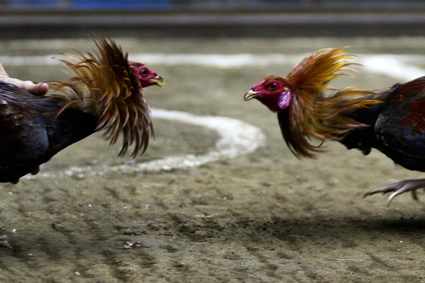
The day’s fights are first prepped during the Ulatan phase. Outside the arena, in the holding-pen area.. the fighting cocks are paired up based on similar weight, wing span, etc. so the matches are as fair as possible. Once this pairing has been established each bird is fitted with a single, sharp blade.. usually on the left foot. It is shaped like a small sickle or spur about 2 to 3 inches in length.
The next step takes place inside the arena, known as the Ruweda. There are four men in the arena with the fighting cocks; the 2 Owners of the birds, the Announcer (known as the Casador) and the Referee (known as the Sentensyador). The ruling of the Sentensyador is
However it is only once the Casador (announcer) shouts out, “Larga na!!” that all chaos breaks loose. For it is at this point that the gamblers begin shouting in a mad frenzy to place their bets from the stands. Within the stands are the person who take the bets, known as the Kristos. They get this name for having their arms spread out as they signal the bets with hand motions. There are other persons who act as ‘bookies’ who will combine your bet with theirs to get better odds, but most people make their bets directly with the Kristos. It is very loud and chaotic at this point because only about 3-4 minutes are allowed for betting prior to each match. Once the Casador announces the END of betting, the next stage begins and no more bets are taken.
Regarding the hand-signals for placing bets, a system is used to communicate with the Kristos as to how much of a bet is being placed over the loud shouting that ensues. First
At this point the actual battle begins. The roosters are placed within 12 feet of each other allowed to naturally decide when the bout will begin. At this point the Owners must back away or risk being forfeited for interference. Once the cocks are set loose only the Sentensyador (referee) is allowed to reset the birds into a fighting position or inspect the birds to make a final decision. He is also the only one allowed within six feet of the actual combat.
Most matches last between 2 to 5 minutes at the longest. I have seen several matches in which the two birds ran straight for each other, had a 2 second mid-air conflict and instantly one bird fell to the ground fatally losing the match. It can happen that quickly so everyone is in a heightened state of attention once the birds are set loose for each fight.
To one side of the arena is the area for the birds known as the ‘Meron’. The Meron cock is the champion, or ‘favored’ bird in the betting stats. The fact that he even survived from his last bout to appear is something taken into consideration. But for many Meron birds it is their first fight, however these are the owners with large money behind them who have a
To the other side of the arena is the area for the ‘Wala’. The Wala bird is the newcomer, amateur owner’s bird and is the ‘underdog’. Odds are higher for the Wala, if it wins, since it is going up against a favored bird in its weight class. But odds are also higher it will lose.. although in cock-fighting just about anything can happen. A lucky strike.. a wing bone to the ribs, a positional advantage.. it is every amateur’s hope that their Wala bird will exit as the victor and make him some money. An orange or red tape is often placed on the left leg of the Wala bird so that it is distinguished from the Meron during the bout. When both birds are the same color and breed this is very helpful. Sometimes each bird is a completely different color, which helps.
Betting Terminology: Parehas (Even odds), Lo dies (100 wins 125, 200 wins 250, 400 wins 500), Walo-anim (300 wins 400, 600 wins 800), Onse (400 wins 550, 800 wins 1100), Tres (1000 wins 1500), Sampu-anim (600 wins 1000) and Doblado (1000 wins 2000)
Author: Reekay V.
Since 2012 I’ve been traveling through various islands of the Philippines as a full-time Expat and spent 1999 living in Vietnam.
Share with me my ongoing adventures of life in the Philippines. Hopefully you find my observations helpful in your own adventures.
— Reekay